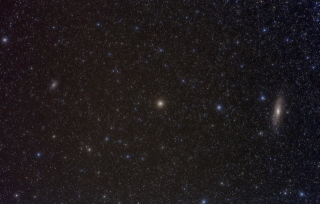Chap.1 Introduction
The extrasolar planet Pegasus 51B, discovered in 1955, was a large planet
like Jupiter but it closes to its host star. Like the exoplanet Pegasus
51B, giant gas planets are easy to discover when they exist near shining
stars, and they are discovered one after another and called a hot Jupiter.
It is difficult for the hot Jupiter to be born in an orbit near host star,
nor to transfer the orbit close to the host star and stay in the fixed
orbit.. Therefore, the hot Jupiter was born and formed before the star began its fusion reaction.
The birth of a star and the birth of a planet in the stellar system may
coincide. The celestial body with large gravity accelerated their growth.
So, the largest planet will start the nuclear fusion reaction more than
the other planet. The planetary planets of the solar system can be thought
to have almost formed when the Sun began to nuclear fusions. By the way,
the snow line occurs and exists after the Sun initiates the nuclear reaction.
The snow line is about 2.7 AU and is located around the main belt of the
asteroid belt. In space outside the snow line, the temperature is low where
CO2 and H2O exists as a solid. These solid particles promote the formation of planets
by an accretion.
On the other hand, inside of the ice boundary, H2O exists as gas molecules, not ice. In a terrestrial rocky planet this inside of the ice
boundary, molecule of CO2 or H2O is a gaseous state. It is difficult to grow containing CO2 and H2O.
Therefore, when the Sun began nuclear fusion, terrestrial rocky planets had formed with ice and dry ice .
The Sun had a fusion explosion, causing the core of the Sun to fly away
and eject large amounts of meteorites. Radioactive dating of meteorites
indicates that the meteorites were born 4.6 billion years ago. The crust
of terrestrial planets was heated due to the large number of meteorites
fall, and those accompanied with magma oceans. The primary atmospheric
of H2 and He are blown away by the solar wind, and the second atmospheric of
CO2 and H2O were emitted to the atmosphere by the degassing. Now, the planet's atmosphere
is constantly impacted by the solar wind, which is a high-speed hydrogen
ion (H+) emitted by the Sun.
The high-speed H+ of the solar wind has a mass 1836 times larger than that of an electron, and it has the large kinetic momentum,
and when it collides with the planet's atmosphere, It drives atmospheric flow that rotate around the planet.
When charged particles become faster, they have magnetism, and when the same charged particles run side by side,
the attraction acts like parallel currents, and when two high speed H+ run side by side, they are magnetically coupled. On the other hand, when electrons and H+ run side by side, the magnetic repulsive force acts. Therefore, the magnetic
coupling effect extends the lifetime of the solar wind plasma, and the
solar wind reaches the edge of the solar system. This website describes
the formation of the solar system based on the model that the planets of
the solar system were born before the Sun began nuclear fusion reactions. (Last
modified Feb/26, 2023 )

[CG was provided by Pixta]
[References] Martin Reese, "Space Encyclopedia", 0Dorling Kindersley
book, 2012
index -1.1-